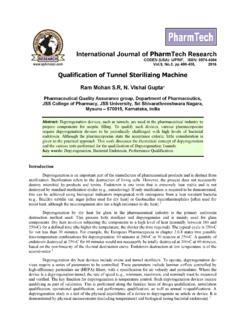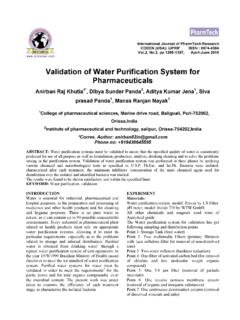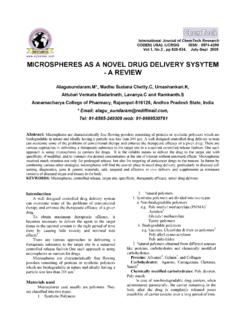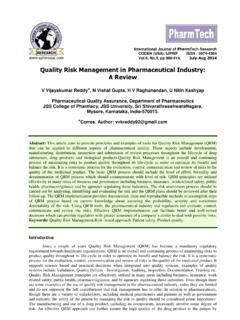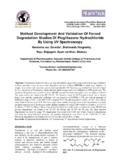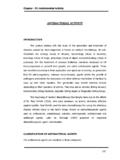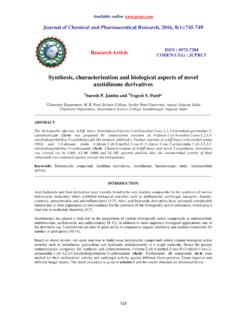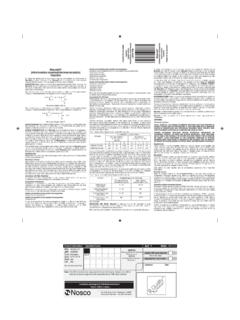Transcription of Microbial Production of Vitamin B12 and Antimicrobial ...
1 International Journal of ChemTech Research CODEN( USA): IJCRGG ISSN : 0974-4290. , , pp 976-982, July-Sept 2012. Microbial Production of Vitamin B12 and Antimicrobial Activity of Glucose Utilizing Marine Derived Streptomyces Species *, , Udaya School of Engineering, Udaya Nagar, Vellamodi, Ammandivilai Post, Kanyakumari District-629204, Tamil Nadu, India. * : Mobile number: +91 9551144602. Abstract: One of the most alluring and fascinating molecules in the world of science, food and medicine is Vitamin B12 (cobalamin), which was originally discovered as the anti pernicious anemia factor. In current study, fifteen marine derived Streptomyces species were isolated from the marine sediment and identified by the morphology biochemical analysis. The batch fermentation process was used for the Production of Vitamin B12 at optimal conditions with specific fermentation medium.
2 Among fifteen Streptomyces isolates, seven produced Vitamin B12 and quantified its concentration range from g to g per ml. Streptomyces rochei produced maximum amount of Vitamin B12 ( g per ml). Among the seven Vitamin B12 produced Streptomyces species four used for the antibacterial activity and exhibited broad antagonistic spectrum against all tested selective human pathogenic bacteria. These activity measured by zone of inhibition (mm), by agar well diffusion method. Altogether, the results indicated that the natural marine environment is also good sources for isolation of novel varieties of antagonistic Streptomyces species and to produce Vitamin B12. Key words: Streptomyces species, Vitamin B12, Antibacterial activity and Marine sediment. INTRODUCTION functioning of the brain and nervous system and for the formation of blood. It is normally involved in the Marine Microbial technology has opened a metabolism of every cell of the human body, wide area for finding novel organisms for trapping especially fatty acid synthesis and energy their potentiality.
3 The microorganisms growing in Production . It is the largest and most structurally marine environments are metabolically and complicated Vitamin and can be produced physiologically diverse from terrestrial organisms industrially only through bacterial fermentation- (1). The novel marine actinomycetes are valuable synthesis (4). Streptomyces is the largest genus of source of new bioactive compounds (2, 3). Vitamins Actinobacteria , over 500 species of Streptomyces are regarded as organic compounds required in the bacteria have been described. Streptomycetes are diet in small amounts to perform specific biological characterised by a complex secondary metabolism functions for normal maintenance, optimum growth (5) and they produce over two-thirds of the clinically and health of the organisms. Vitamin B12. useful antibiotics of natural origin ( , neomycin, (cobalamin, anti-pernicious anemia factor) is a water chloramphenicol).
4 Streptomycetes are infrequent soluble Vitamin with a key role in the normal pathogens, though infections in human such as et al ,4(3) 977. mycetoma can be caused by S. somaliensis and S. ml of sterilized physiological saline and this sample sudanensis and in plants can be caused by S. was serially diluted up to 10 - 4 dilution. Each test caviscabies and S. scabies (6). It is a unique Vitamin , tube of diluted samples were vortexed vigorously for synthesized by only microorganisms and not by 15 minutes. animals and plants. Vitamin B12 has been isolated from fermentation broths of numerous PREPARATION OF BENNETT MEDIA. microorganisms, including antibiotic-producing Bennett Media composition actinomycete (7). Industrial Production of Vitamin B12 is through fermentation of selected INGREDIENTS QUANTITY. microorganisms (8). Determination of Vitamin B12 1 Beef extract 1g Production was carried out using spora, 2 Yeast extract 1g Mycobacterium, Nocardia, Propionibacterium, 3 Casein digest 2gms Proteus, Pseudomonas, Rhizobium, Salmonella, 4 Agar 17gms Serratia, Streptomyces, Streptococcus and 5 Glucose solution 20ml Xanthomonas.
5 Vitamin B12 is provided as a (25% w/v). supplement in many processed foods and is also 6 Maltose solution 20ml available in Vitamin pill form, including multi- (25% w/v). vitamins. Vitamin B12 can be supplemented in 7 Nystatin solution 20ml healthy subjects also by liquid, transdermal patch, ( ). nasal spray, or injection and is available singly or in 8 Sea water 470ml combination with other supplements. It is a common 9 Double distilled 470ml ingredient in energy drinks and energy shots, usually water at several times the minimum recommended daily allowance of B12. Streptomycetes are the most well known genus of Actinomycete family which always has been notified because of their ability to produce After adding the ingredients, the pH was adjusted to before autoclaved. and secrete a large variety of industrial, medical, biotechnological and agricultural secondary metabolites (9).
6 Based on several studies among bacteria, the actinomycetes are noteworthy as ISOLATION AND IDENTIFICATION OF. antibiotic producers, making three quarters of all STREPTOMYCES SPECIES. The serially diluted samples were spread evenly known products; the Streptomyces are especially prolific ( 10, 11,12). The marine derived antibiotics on the media and kept it for incubation at 37 C for 96 hours. After incubation, Streptomyces species are more efficient at fighting Microbial infections were identified by morphological and biochemical than the terrestrial bacteria have not developed any methods. Morphological methods consist of resistance against them (13). The present study was macroscopic and microscopic methods. The aimed to isolate Streptomyces species from marine sediment and assess their Vitamin B12 productivity microscopic characterization was done by cover slip culture method (14).
7 The mycelium structure, color and antibacterial activity against selected human and arrangement of conidiospore and arthrospore on pathogenic bacteria. the mycelium was observed through the oil immersion (1000X). The observed structure was MATERIALS AND METHODS. compared with Bergey's manual of Determinative SAMPLE COLLECTION Bacteriology, Ninth edition (2000) (15) and the The marine sediment sample was collected organisms were identified. Various biochemical tests from muttam sea, Nagercoil, kanyakumari District, performed for the identification of the potent isolates Tamil nadu, India at 10 m length and 5 m depth in are as follows: Casein hydrolysis, Starch hydrolysis, sterilized glass bottle. The collected marine sediment Tween 20 hydrolysis, Urea hydrolysis, Esculin sample was stored in ice box and then transported to hydrolysis, Acid Production from sugar, NaCl the laboratory within 3 hours.
8 Resistance, Temperature tolerance. PREPARATION OF MARINE SEDIMENT INOCULUM PREPARATION. SUSPENSION AND SERIAL DILUTIONS The suspension was prepared for each strain and 20 grams of marine sediment was 24 hours old slant culture was used. The inoculum transferred into 250 ml conical flask containing 100 was prepared by transferring 5ml of suspension into et al ,4(3) 978. 100ml conical flask containing 45ml of sterile (Test / Standard ) Concentration of inoculum medium. 50% of sea water and equal standard solution. volume of double distilled water was used to prepare the inoculum. Then it was kept in electric shaker PREPARATION OF CELL FREE Microbial . with 100 rpm for 24 hours. The medium described EXTRACT. by Tanaka et al., 1974(16) was modified and The culture medium was prepared, contained NH4PO4, ; KH2PO4, ; sterilized and inoculated with fresh culture of the , ; , ; four selected Streptomyces strain.
9 The cultured H2O; ; , ; and flasks were incubated at 37 C for 24 hours. After g glucose per 50ml. incubation time the cultures were centrifuged at 12000 rpm and their supernatant was used for FERMENTATION PROCESS further experiments. Fermentation studies were carried out in the conical flasks. Fifty milliliters of 24 hours aged ANTIBACTERIAL ACTIVITY. inoculum at the ratio of 10% (v/v) was added to 200 Muller Hinton Agar was prepared according to ml of Production medium in 250 ml of conical flask. the manufacturer's instructions. The medium was The glucose was used as a carbon source. The pH of sterilized by autoclaving at 121 C for 15 minutes at culture was adjusted to and the fermentation was 15 psi pressure and was used to determine the carried out at 300C for 5 days. The growth of antibacterial activity of Streptomyces species. Sterile bacterium and Vitamin B12 Production was molten cool (45 C) agar was poured aseptically into measured.
10 The fermentation medium used contained sterile Petri plates (15 ml each) and the plates were (g/l) NH4PO4, 2g; KH2PO4, 2g; , ; allowed to solidify at room temperature in sterile , ; H2O, ; condition. After solidification and drying, the plates , ; , The were seeded with appropriate micro organisms by glucose was used as a carbon source. streaking evenly on to the surface of the medium with a sterile cotton swab and wells (8 mm diameter). BIOMASS ESTIMATION were cut out from the agar plates using a sterile 2ml of culture sample was centrifuged at 8500 stainless steel bore and filled with of the each rpm at 40C for 15 minutes then the cells were supernatant solution of Streotomyces species in collected and washed with sterilized distilled water. respective wells. Tetracycline used as a control. The pellet was then desiccated in an electric oven at Then the plates were incubated at 37 C for 24 hrs in 1050C until constant weight obtained.
